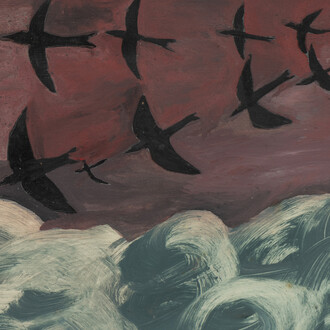Memory is a locket that holds the loved face. Sometimes it opens, then I gaze and remember, until it clicks shut.
(Dorothy F. Foster)
Little is known about Dorothy F. Foster’s work. Clues abound, but the true meaning behind her enigmatic drawings remains a mystery. Rendered in ballpoint pen on newspaper clippings, the works are innately regenerative; Foster coaxed anonymous faces from the contours of found imagery, introducing brightly dressed creatures and patterns to complete each scene. They divulge the artist’s sensitivity and openness to the unknown, yet their exact significance remains obscure. What these strange characters and abstractions represent may only be understood through Foster’s breadcrumb trail––playful titles, poetry, recurring themes––and one’s own intuition.
Foster’s autobiography, The Noisesome Day, the Stilly Night (1973), is one such clue, haphazardly chronicling birthdays, arguments, urban life, and a sister’s potential clairvoyance. It leaps from the steady and pleasant quotidian to profound reflection. Thoughts inevitably arrive and pass. The book is likely named after Thomas Moore’s Oft, in the Stilly Night (Scotch Air) (1850), a poem grieving the impermanence of life and longing for moments past:
Thus, in the stilly night,
Ere slumber’s chain has bound me,
Sad memory brings the light
Of other days around me.
Touched by this sort of melancholy yet not overwhelmed by it, Foster’s drawings balance an unsettling darkness with playful mystery. Foster’s writing, too, urges an acceptance of endings:
With the passage of time I wonder why we turn away. Even change, changes…white bones merge with brown earth. Hands in quest of life plunge deep into decay.
Despite their palette, Foster’s drawings leave room for lightheartedness. Many of the figures possess a sweetness, gentle in their elliptical journeys. Some drawings indicate multiple planes: Crossing (Mulberry + Grand Sts) refers to an intersection in New York, yet the articulation of its ethereal pedestrians suggest another realm; Sleepless evokes a busy crowd or perhaps the mind of a single dreamer. Others possess a strong sense of longing, or a fondness for a certain place or habit. Almost all are framed in gleaming black borders reminiscent of a curtain-lined stage, where figures in pointy hats appear as both subject and visual motif. Overlapping shadows suggest multiple doorways, guiding the viewer somewhere dark and alluring. Blurred apparitions embrace; rich reds and greens glow like sun pouring through stained glass. Their design culminates in cryptic memories, lucid but for their undeniable fantasy.
Born in Jersey City in 1903, Foster and her two younger sisters grew up in a Manhattan transformed by the Roaring Twenties, the arrival of Art Deco, and the strains of the Second World War. After studying art and interior design at the Cooper Union, Foster began her career as a textile designer, painting and writing poetry in her free time. In retirement she continued her practice, creating hundreds of drawings and poems, including the autobiographical log of one year in New York: The Noisesome Day, the Stilly Night. The drawings presented here were created in her final years, only exhibited after her death in 1986.
With special thanks to Claire Iltis and Fleisher Ollman.
















